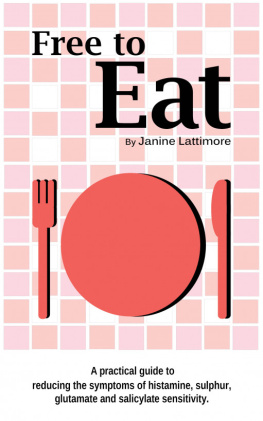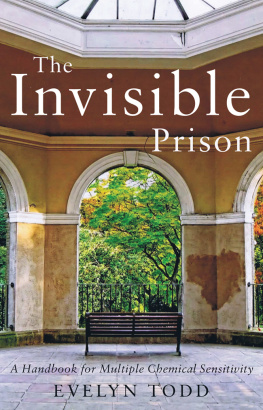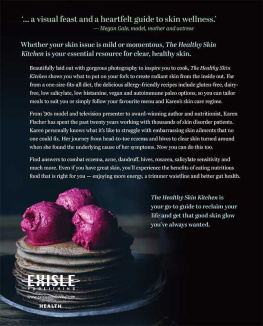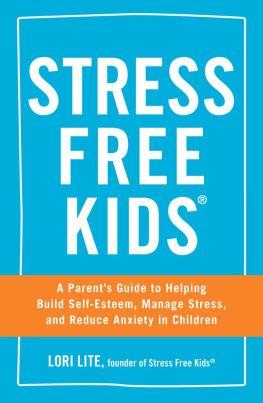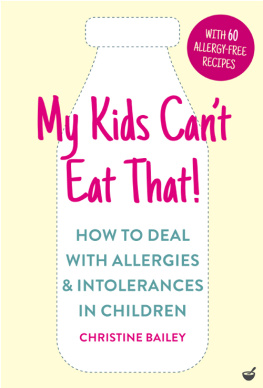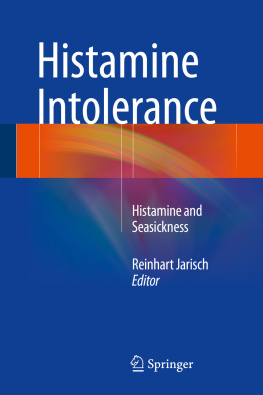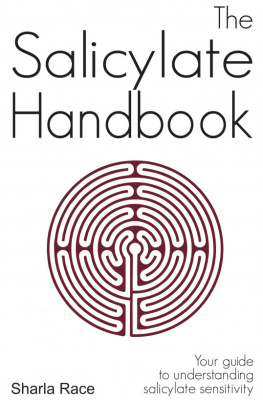Freeto Eat
A practical guide toreducing the symptoms of
histamine, sulphur,glutamate and salicylate sensitivity
By Janine Lattimore
Copyright 2015 JanineLattimore
Distributed bySmashwords
Fifth Edition
Introduction
How This Book Can HelpYou Please read this first
There are somegood books and resources available about what causes foodintolerances, how to identify them, elimination diet protocols,food lists and recipe ideas. What I struggled to find was a book onhow to get better. I didnt want myself and my children to have tolive on severely restricted diets, and I didnt want to live mylife in constant anxiety that I would inhale, touch or consumesomething that would cause my skin to erupt in painful, ugly spots,rashes and itching. To avoid all the things we reacted to we wouldhave to live in a bubble surviving on a diet of lettuce, celery,boiled fresh meat, rice, pears and banana. I found informationabout treatments and remedies scattered across forums and blogs,but no book that put it all together in a practical way. So I wroteone.
Free to Eatoutlines what I have found out by research and then trial and errorto reduce the food intolerance symptoms caused by histamine,sulphur, glutamate and salicylate sensitivity in myself and mychildren. It is the how to handbook I wish someone had given meafter we had identified our food intolerances and chemicalsensitivities. While I read scientifically researched informationto identify treatments, this book simply outlines the remediesthemselves that we, and fellow chemical intolerance sufferers, findeffective. There are very few why explanations, just the what todo based on what experience has shown to be effective. I wanted tokeep this book as basic to read as possible, because I myself foundthat some of the information available about these intolerances isvery technical and sometimes all I wanted was a basic explanationof what I could do to manage our illness. Free to Eat is aneasy to follow step by step plan to reducing your food intolerancereactions so that you can eat a wide variety of foods and live arelatively normal life.
Free to Eatwill help you reduce the symptoms of yourchemical intolerance and increase your tolerance levels by showingyou how to:
Implement quickeasy strategies to reduce stress
Incorporateenjoyable exercise into your life
Eat and drinkthe right things in the right way to heal your body
Groom yourselfto look good using chemical-free/safe products (including make-up,hair-styling and hair removal)
Use safetreatments for day to day ailments (including reducing coldsymptoms, easing itching, and reducing reaction symptomsquickly)
Take minimaleffective nutritional supplements to boost your bodys digestiveand detoxification function
Keep your homehygienically clean using chemical-free/safe products
And muchmore.
I am sharingthis information simply because this is what works for us andbecause I want to help other people with chemical intolerances as Iknow how difficult they can make our lives.
This book iswritten for people who have already identified that they have anintolerance or sensitivity to one or more of the following:salicylates, histamines/amines, sulphur and glutamates. It may seemambitious or even a little confusing to write a book covering allthese chemical intolerances, but the reason I have is because it isquite common that if you suffer from one chemical intolerance youalso experience intolerance to other chemicals (I suffer from themall). Moreover, many of the management strategies in terms oflifestyle and supplementation are the same for all of thesechemical sensitivities.
Free toEat does not cover the symptoms of chemical/food intolerance,how to identify which chemicals you are sensitive to or eliminationdiet protocols. It also does not include food lists because itcovers so many different chemicals and this is well covered inother resources. For information regarding symptoms,identification, elimination diets and food lists see the resourceslisted in the appendix at the end of this book.
Dedication
This book isdedicated to the many wonderful fellow chemical sensitivitysufferers who have researched, trialled, debated, shared andsupported via numerous online forums, Facebook pages and personalblogs. The information you provided was often so helpful and evenjust knowing that I was not alone with my seemingly crazy reactionshelped to make things tolerable when I began to despair. I deeplyappreciate the hope and knowledge you have freely given. I alsowant to give special thanks to:
The FoodIntolerance Network Canterbury especially its wonderful coordinatorRobin Fisher and members Jewel and Catherine who helped me to editthis book
My dietitianClarice Hebblethwaite for her advice and support
Sue Dengate andher husband for their book Fed Up. This was the first bookon salicylate intolerance I read after I learned that I sufferedfrom it and I literally cried as I read some of the stories in thebook because it was like they were describing my daughter. Afteryears of stress trying to manage her poor sleep patterns,excessively defiant, belligerent behaviour and periods of crazyhyperactivity I had finally found what the cause was. I amprofoundly grateful to Sue and her husband for their research,lobbying and provision of information regarding chemicals in foodand their effect on our mental and physical health.
YasminaYkelenstam and her very informative blog The Low HistamineChef
Disclaimer
Throughout thispublication statements are made pertaining to the properties and/orfunction of food and/or nutritional products. While every efforthas been made to provide accurate information, these statements arenot intended to diagnose, treat, cure or prevent any disease.Please seek the advice of a qualified health professional beforeimplementing significant changes to your diet or taking healthsupplements. If you are taking prescription medication, thenconsult a qualified health professional before making changes tothe medication you are taking. Janine Lattimore is not responsiblefor any actions taken on the basis of information contained withinthis publication nor for any error of omission contained herein.Janine Lattimore disclaims all liability in respect of anythingdone or not done in reliance upon all or part of the contents ofthis publication.
Contents
Clarifying theproblem
Allergies
EliminateEnvironmental Chemicals Before Altering Your Diet
TheFourfold Aim
Free toEat outlines numerous measures that you can take in terms ofpersonal care, cleaning, leisure, lifestyle and nutritionalsupplementation to help you reduce your chemical sensitivities. Themeasures discussed in this book are based around a fourfoldaim:
Fourfold Aim:
1. Heal yourdigestive system and improve its functioning
2. Calm andstrengthen your immune system
3. Reduceinflammation in your body
4. Increase theefficiency of your bodys detoxification pathways
Between my twochildren and I we experience intolerance and sensitivities to:salicylates, amines/histamine, sulphur, glutamates, gluten, eggs,soy, corn, fructose, citric acid and dairy. Theseintolerances/sensitivities were identified through many months(years) of following an elimination diet and keeping daily fooddiaries coupled with visits to a dietician who specialized inchemical intolerances. Our main symptoms and specific intolerancesdiffer slightly but we share most of the above in common. I mainlyexperience symptoms in my skin such as hives, eczema and acne, butI also experience brain fog, intense anxiety, fatigue, excessivehunger, back pain, muscle pain, very low blood pressure and lowblood sugar levels. My daughter mainly exhibits behaviouralsymptoms such as making constant nonsense sounds, being excessivelydefiant/contrary, excessive emotional responses/tantrums, overlyloud talking and difficulty going to sleep and staying asleep. Shealso experiences brain fog, anxiety, increased hunger (we call itthe hungries) and excessive forgetfulness (e.g. she will ask thesame question repeatedly over a short space of time forgetting shehas asked it or what the answer was). My son mainly experiences gutpain and discomfort, but also excessive agitation/mildhyperactivity at times. When I wrote this book my son had justturned four and as he was so young and had experienced issues withmost foods it was difficult to tell if he had the same chemicalsensitivities as my daughter and I or rather an extremely sensitivegut. As he has gotten older I have been able to clarify that hedoes actually have many of the same chemical sensitivity issues,though his salicylate sensitivity is milder than mine and mydaughters, but his citric acid intolerance was much higher.
Next page
